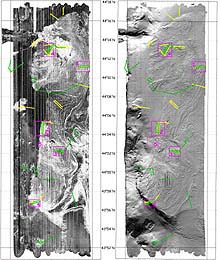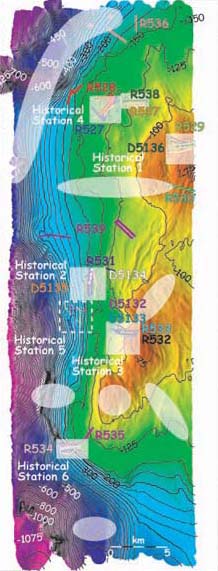
Heceta Bank Simrad EM 300 backscatter (left) and topography (right). Grids for both images are 10 meters. ROPOS ROV dive tracks 2000 (yellow) and 2001 (green) overlay imagery. The backscatter image reveals seafloor physical properties and texture of the seabed. White areas depict high reflectivity (cobble, boulder and sand). Black areas depict low reflectivity (mud). The topography image is "illuminated" from the northwest The shelf break is apparent on the southwest portion of the bank. Ridges, folds and jointed bedding planes are easily discerned on the shallow portions of the bank. Click image for larger view.
Simrad EM 300 high resolution side-lit multibeam bathymetry of Heceta Bank. "Lighting" is from the northwest. Grid cell-size is 35 meters, with 25 meter contours superimposed. White shaded and dashed boxes show historical Delta (D*) submersible dives stations. White shaded ellipses represent areas of ROPOS ROV dives in 2001. Click image for larger view.
Summary of the Heceta Bank mission (Phase 3 of the Expedition)
July 4 – July 13, 2001
Bob Embley and Waldo Wakefield
Co-Chief Scientists
Lewis and Clark Legacy Ocean Expedition
Heceta Bank was the site of 58 submersible dives in the late 1980s, which characterized the bank's species composition and provided important data on the relationship between fish species and bottom types. The acquisition of a state-of-the-art, high-resolution sonar survey at the site in May 1998 provided a highly detailed, precisely navigated seafloor map of bathymetry (depth) and sea-floor texture, which serves both as a context for the 1980s data and as a basis for the current, comprehensive study of groundfish/habitat relationships over a larger area.
Over the course of the nine-day operation on Heceta Bank, 15 ROPOS ROV dives were completed with a cumulative submerged time of 133 hours. The focus of the ROV dives was divided between conducting quantitative day-time transects to measure abundances of fishes and invertebrates (8 dives), and night-time excursions to explore the Banks geology and conduct intensive biological sampling (7 dives). ROPOS dives were completed at 5 of the original historical Heceta Bank study sites, dating back to the late 1980’s. The same 5 study sites were explored with ROPOS during a cruise aboard the Ronald H. Brown in June 2000. In addition, seven entirely new sites were explored in areas of the Bank critical to establishing a comprehensive picture of the range of the Bank’s benthic habitats.
At the completion of the field portion of this exploration, members of the scientific team from up and down the West Coast, began the time-consuming process of extracting the biological and physical data from each of the ROPOS’s quantitative video transects. The acquisition of data from the broadcast-quality video will require experts in several disciplines to review the archived tapes, and will take many months. The extensive set of quantitative transects will provide critical insights as to changes that may have occurred in the fish and invertebrate populations over the last decade -- a period that coincided with intense commercial trawl fishing.
The ROPOS ROV’s array of sophisticated sampling equipment provided members of the scientific team with the tools to view and sample both geological structures and marine invertebrates. Biological specimens and geological samples that are invaluable to museums and universities were collected. Hundreds if not thousands of specimens of benthic invertebrates were sampled, and these specimens will be sorted, identified, and curated as part of a permanent collection at the Los Angeles Museum of Natural HistoryAs was the case during the Phase II operations in Astoria Canyon, a team of biological oceanographers conducted acoustic transects both between and during each ROPOS dive using the towed Simrad Ek500 echo sounder to image and quantify aggregations of fish and zooplankton. In addition, samples of multiple trophic levels from the Bank’s food web were collected for subsequent studies of stable-isotopes in the laboratory, so scientists might better understand the trophic dynamics at work in the vicinity of this deep-water rocky bank. In addition to the oceanographic experts directly involved in the Lewis and Clark Legacy exploration, the Heceta Bank portion of the project complements several ongoing West Coast oceanographic research programs that focus in part on this deep-water rocky bank, including the Coastal Ocean Advances in Shelf Transport ![]() (COAST) Program, and the U.S. GLOBEC Northeast Pacific Program
(COAST) Program, and the U.S. GLOBEC Northeast Pacific Program ![]() .
.
In addition to the critical fisheries habitat studies conducted during the Heceta Bank cruise, a number of additional important discoveries were made. The high resolution multibeam maps showed that the outer edge of Heceta Bank had a distinct change in bottom character, suggesting the trace of an ancient shoreline. In one place, there was a sudden rise projecting to the west that looked much like a rocky headland found along the present Oregon coast. In approaching this ancient headland, it became obvious that there was abundant shell material in the sand next to the cliff. Fortunately, the science party aboard the Ronald H. Brown included Dr. Ángel Valdés, a specialist in Malacology (mollusks) from the Natural History Museum of Los Angeles County. Dr. Valdés recognized some of these shells as shallow water and intertidal. Numerous shells were found in the sands of this ancient beach. A perfectly intact mussel shell recovered from this site has been dated by John Southon at the Lawrence Livermore Laboratory ![]() at 13,120 radiocarbon years (translated to 14 to 15 thousand years old).
at 13,120 radiocarbon years (translated to 14 to 15 thousand years old).
The discovery of this 14,000 year old shell raises many questions. The water depth here is 140 meters, but we know from numerous studies that the absolute sealevel change at this time was only about 120 meters. This implies that Heceta Bank has subsided more than 20 meters during the past 14,000 years. The subduction of the ocean plate beneath Oregon is likely the overall cause of this although the exact mechanism for the subsidence is unknown.
The last Ice Age ended only 15 to 18 thousand years ago, only a moment in the earth’s history. The first human explorers to reach North America probably came during this period, but we know virtually nothing about the routes they took or where they may have settled first. If some of these early migrations were along the coast, we need to look out on the continental shelves to find the evidence. This discovery provides the first information on the position of the shoreline along which some of these early explorers may have journeyed. The Ocean Exploration Program offers a new opportunity to understand this earliest phase of our cultural heritage.
Sign up for the Ocean Explorer E-mail Update List.






























